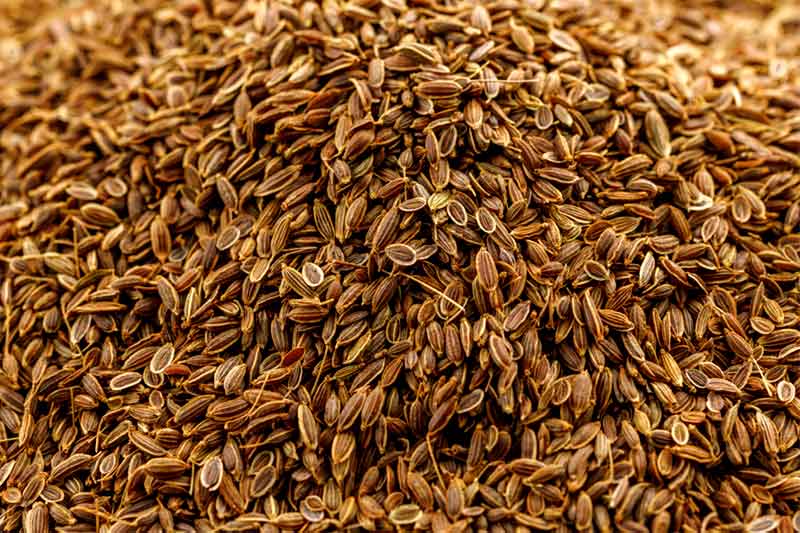Quick Facts
Botanical Name: Anethum graveolens
Family Name: Apiaceae
Common Name: Anethum graveolens
Parts used: Seeds and stems
Specific Gravity: 0.946 (0.910 to 0.980)
Optical Rotation: 71.5 Degree, +72.5 degrees
Blends Well With: It has grass like smell and is pale yellow in colour, can be diluted with water to make dill water.
Uses: This oil is used to cure digestive problems in adults. This oil is best to reduce oral inflammation.
Countries where it is found
This plant is found in the Arctic Circle which is regarded as most optimal place for the cultivation of dill though basically it originated from Russia and European region.
Harvesting Information
The Arctic Circle provides superb conditions for its cultivation. For cultivation of the particular seed, warm to hot summers are required, even a little less temperature can reduce the production. Hot sunshine is the foremost thing, which it needs to grow. These seeds work for three to ten years. Flower heads are cut when it ripens and they are covered with paper bags from the upper part and left again in the heat, after getting loose from the stems, they are stored in containers which are fully airtight.
History of the Plant
History of the seed of Dill indicates that it originated in Mediterranean European, southern Russian countries and west Asian countries. The remarkable tomb of AmenhotepII was also reported to have the tiny branches of dill. Dill means "to lull', which indicates the use of dill seeds in the plight of insomnia. Greeks and the Romans used this as an Ayurvedic medicine on the bodies of burnt warriors. In the medieval period, as so many superstitions prevailed that time, these seeds were an important ingredient of love potions, used for casting spells and also in potions made to keep people away from witchcraft. People used to assume these seeds were very pious and carried them for saving themselves from curses and hexes. Cultivation of "dill seed' can also be read in the history of Neolithic arrangements in Switzerland. Some traces of consumption of this seed are also found in Roman and British culture too.

Extraction Process
It is essentially extracted from the seeds or stems of the dill plant. Dill blooms in southwest Asia when the days are much warm and nights are not long. These plants grow from three to five feet in length, with lacy yellow flowers on sham and hard stems.
Commonly known Benefits
€¢ Dill is used for solving digestive problems of adults; it should not be given to kids as it is too strong
€¢ In adults, it helps to increase appetite, solves liver problems and fights with urinary infections. It regulates urine and removes the problem of painful urine.
€¢ It is used for fever, colds, sleep disorders, coughs, nerve pains, bronchitis, spasms, infections etc.
€¢ Dill can be wonderfully helpful in reducing oral inflammations like mouth and throat. Dill seed is sometimes applied for oral pain and swelling (inflammation).
€¢ As a cooking spice, it is used in many recipes. Many soaps and perfumes are made with it because of its fragrance.
€¢ Hiccups and constipation problems are solved with the help of "dill' oil. It also relieves tension and keeps our nervous system fit.
-
By mistake I entered the wrong pin code and my order was shipped back. But the helpful customer care helped me to get the same product without any hassle. Also, product was amazing. I highly recommended their service
Ann Caren-Madrid (Spain) 11 August, 2013
-
By mistake I entered the wrong pin code and my order was shipped back. But the helpful customer care helped me to get the same product without any hassle. Also, product was amazing. I highly recommended their service
Ann Caren-Madrid (Spain) 11 August, 2013
-
I really appreciate your products and the awesome client servicing that you are providing. Dill Seed oil was really great
Harriet Chun Finland 17 September, 2013
-
Your dill seed oil is of top notch quality and will certainly order more of these products. Received the product quickly so special thanks for it
Lara Foffa, London 28 November, 2013
-
The Dill Seed oil of is worth every penny that it costs. The pure and smelling oil can be put to a lot of uses and I suggest that all should always keep a bottle of this oil at your home.
Matt D Souza From Australi (Caloundra) 16 December, 2013
Write a Review





